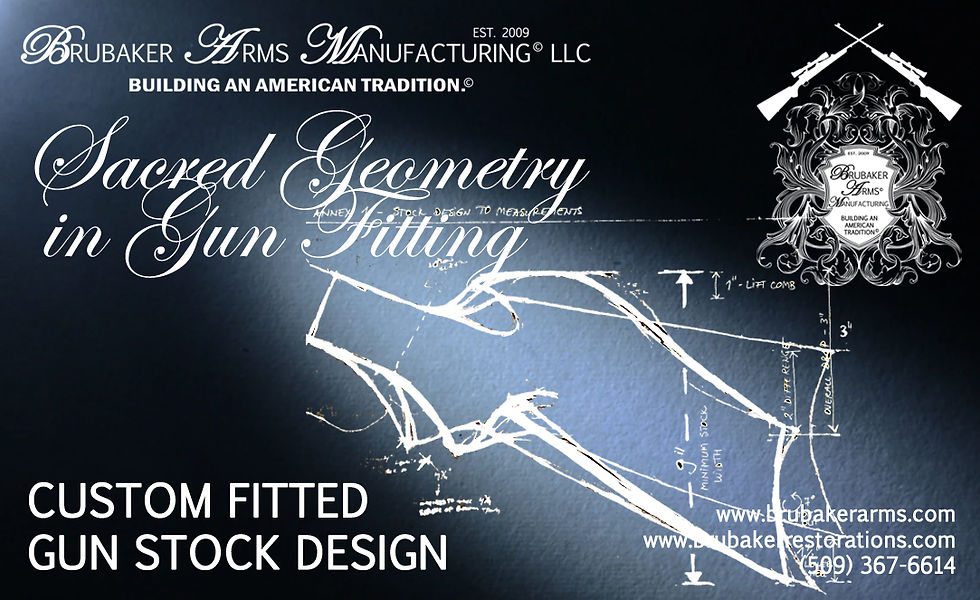A Quick Guide To Understanding Gunsmithing Prices and Second Hand Firearms
- Brubaker Arms - Restorations Department
- Mar 24, 2023
- 4 min read
The quotes that are provided by a gunsmithing shop are usually based on the gunsmith’s experience and careful tracking of how much time he *usually* spends on similar projects. For instance, after cleaning a few hundred rifles, a gunsmith is able to estimate what the cost for cleaning a rifle in average condition is. The rates are hourly, and the quotes are usually based on how many hours it takes to complete a project like yours on another similar firearm, in average condition. A “firearm in average condition” is a firearm that is at least field strip cleaned regularly, with no residue left inside the action to harden, and with no rust or pitting.
A common mistake is to purchase - for a waaaay too reasonable cost - a firearm that had not been looked after, and assume that the gunsmithing cost for cleaning it up will be the same as for a firearm in “average condition”.
A firearm that costs $1000 on today’s market will need at least the same investment in cleaning it up and bringing it to functioning order. Not all good deals are actually good deals. Firearms that have not been looked after often come with bent consumables, frozen screws, softened springs, rust / pitting and residual powder deposits which can cause binding between parts, feeding issues and a myriad of additional problems.
In the pictures below, we will present a case in which the buyer spent 1/3 of the market cost on the rifle and then just about as much on getting it diagnosed, swapping a few parts and getting it cleaned up. A quick look on the Guns International “sold” section will reveal the real cost of the firearm, and if the cost of the firearm that you are interested in purchasing is too good to be true, prepare yourself to invest just about as much in addressing the firearm’s issues.
Altogether, our customer made a 35% profit, which is not bad at all; but if you are looking for an economical firearm and don’t wish to make an investment in diagnostic cleaning (DCOA), be aware that a firearm sold at 1/3 of the market cost might not be as economical as it seems.
This particular firearm’s diagnostic was:
- Firearm was particularly dirty;
- Extractor was worn out - needed replacement; detent and spring needed replacement as well;
- There was a considerable amount of bur built up inside bolt body, causing binding on bolt head;
- Bore showed some sign of wear but at the date of the inspection was still shiny with sharp rifling – which is why a good clean up was worth it;
- Everything except extractor, detent and spring, looked good.
Our shop ordered and fitted the right parts, polished the bur build up, and diagnosed and cleaned up the rifle. However, when a firearm is being brought in to the gunsmith, all that a gunsmith can do is let the customer know what are the AVERAGE prices for cleaning up an AVERAGE rifle. There is no way to say what is *really* going on inside until the firearm is opened up. This is why, gunsmiths with enough experience know to always quote hourly rates and to make sure the customers know that the rough estimates do not represent the final bill.
A few factors that contribute to the increase or decrease of the costs are suggested below. In our practice, we have learned that when these conditions are met, the customer is best informed and the shop is comfortable to carry on with the project.
1. Tell the truth about what the issue is with the firearm.
Here are a few statistics that will – maybe – shock those with good practices: almost 25% of gunsmith’s customers don’t tell the truth about what happened to their firearm. Why is this?, you might wonder. We assume some people do not actually know the truth, others are ashamed to recognize it, others have forgotten – this happens especially with firearms that have been sitting for a while.
2. Don’t abuse your firearm.
35% of the firearms that cross through the average gunsmithing shop’s doors have been abused either by their owner of by a friend of the owner. Tinkering with the firearm is great, but if something doesn’t go back in easily, it means that something else is not fitted as it should or it is not installed properly.
3. Understand how price lists and quotes work.
Price lists are usually guidelines for average projects. The type of firearm that someone carries might be radically different than the next guy’s firearm, and the same deep clean might mean 2-3 hours for one firearm and might mean ½ hour for the other person’s firearm. There are also brands that are simply not designed to be worked on, but the entire firearm is a consumable firearm – like Llamas, Taurus, Raven, etc. They are very affordable because once they stop working they can be replaced, not fixed. Then, there are also firearms for which there is simply no technical information out there; they might actually be great firearms, even curios and antiques, but they will take more time to work on because they need to be figured out rather than simply assembled.
A gunsmith’s favorite firearm is not usually based on looks or personalization, but on how easy it is to work on and how forgiving the firearm is.




















Your parents are arguably as responsible for your success, if not more! You never would be in the position you are now if it wasn't for you mother and father spending their time and money for all those gun shows in Colorado. In fact, sponsoring you from the beginning when you tried to sell your obws at the gun shows. I remember meeting you and your mother at a gun show in Pueblo, CO. You owe your success to them as much as yourself. Do to them paying for and sponsoring you at that gun show, I purchased a rifle from you several years later. You and Morgan or Ligia are hypocrites.